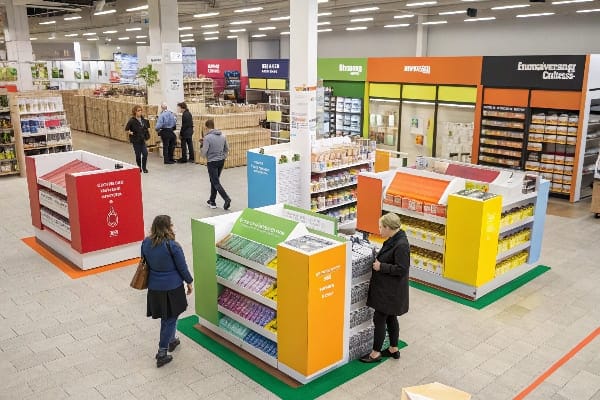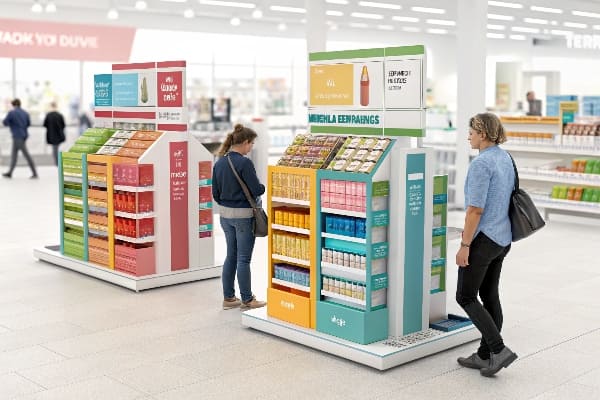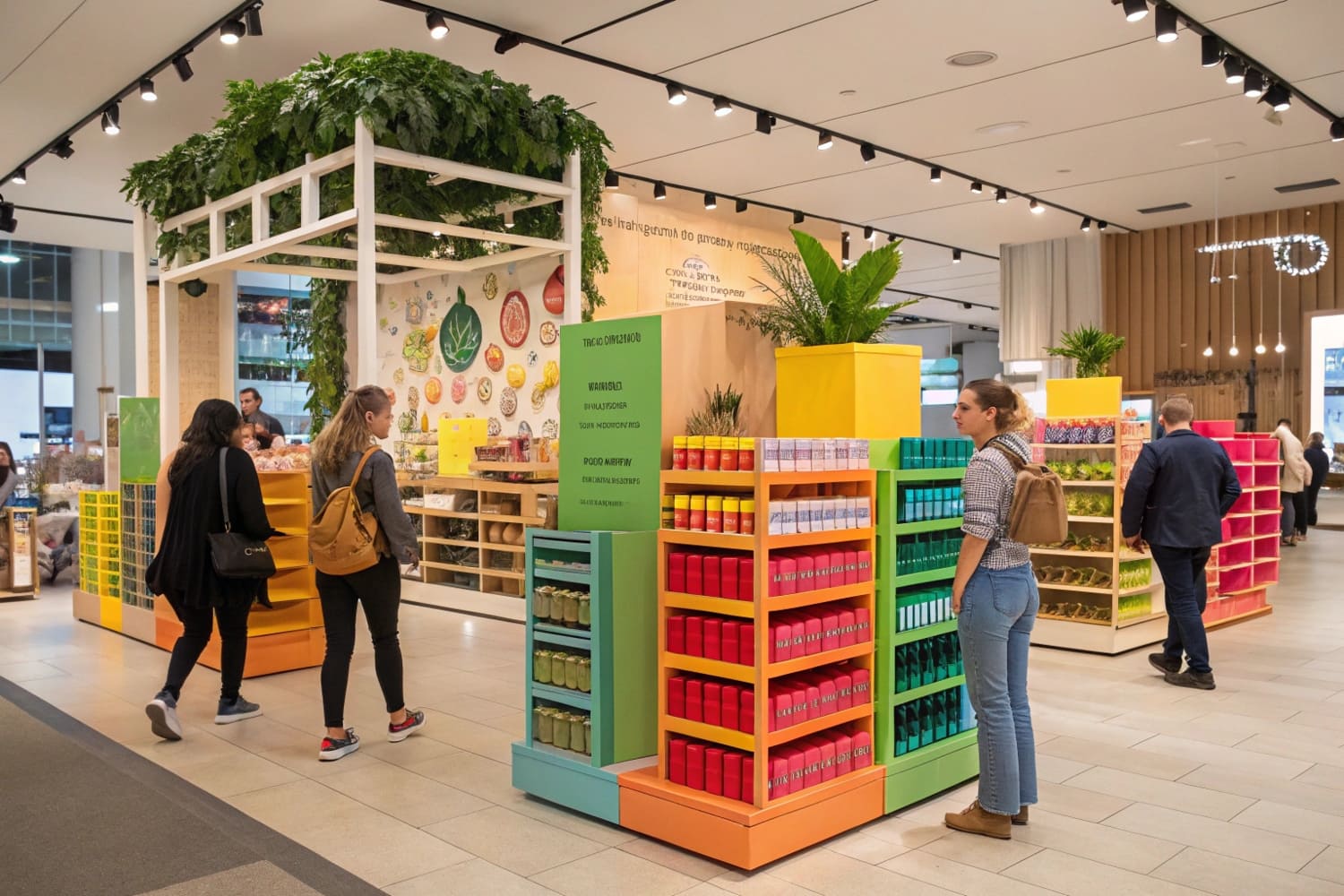買い物客は、しばしば棚がぎっしり詰まった棚を通り過ぎてしまいます。雑然とした陳列を見て、迷子になってしまうのです。私は、シンプルなルール、わかりやすい看板、そして人々の行動を促す、実証済みのスマートなレイアウトで、この問題を解決します。
小売店では、ビジュアルマーチャンダイジングを用いて商品を陳列します。動線を計画し、什器を選び、焦点を定め、照明や看板を設置し、季節ごとのストーリーを伝え、そしてテストを繰り返します。目標はシンプルです。ブランドイメージを維持しながら、注目を集め、選択を促し、売上を伸ばすことです。

深圳でPopDisplayを運営しています。私のチームは、大規模展開用の段ボールディスプレイの設計と製作を担当しています。私は物事をシンプルにすることを心がけています。計画、製作、発送、そして計測の方法をお伝えしています。どの店舗でも同じ手順でできます。
小売業の製品ディスプレイとは何ですか?
商品は素晴らしいものであっても、買い物客が見つけられなければ無視されてしまいます。優れたディスプレイは、目と手を引きつける明確な手がかりで、この問題を解決します。
小売店における商品陳列は、人々が商品に気づき、理解し、購入に繋がるよう、計画的に商品を提示する手段です。レイアウト、什器、照明、看板などを駆使することで、手間を軽減し、疑問を解消し、棚や売場での行動を促します。

それが何をするのか、どのように機能するのか
小売店のディスプレイ1には 3 つの役割があります。すばやく注目を集めること。数秒で価値を説明すること。「今すぐ 1 つ選ぶ」のように次のステップを容易にすることです。私は、計画、モックアップ、テスト、学習、更新というシンプルなループを使用しています。滞在時間2 、タッチ率、ユニット リフトを観察します。コピーは短く、フォントは大きくします。ヒーロー SKU を手の届く高さに配置します。カラー ブロックと明確な値札を使用します。導線は広く保ちます。私は、米国のアウトドア ブランドの全国展開でこのことを苦労して学びました。最初のバージョンは見た目はきれいでしたが、メッセージが曖昧でした。そこでコピーを半分に減らし、デモ ユニットを右側に移動しました。2 週目には売上が上昇しました。
| ゴール | 戦術 | クイックチェック |
|---|---|---|
| 停止 | 太字のヘッダー、照明、動き | 人々は3秒以内に見るでしょうか? |
| 教えて | 3語のメリット3 、ヒーローイメージ | 見知らぬ人が約束を繰り返すことができますか? |
| 売る | 明確な価格4 、簡単にアクセス | 子どもでも安全につかめるでしょうか? |
小売店ディスプレイのさまざまなコンポーネントは何ですか?
多くのチームは派手なアイデアを追い求めますが、その結果は基礎が欠けているために崩れてしまいます。重要なのは各パーツです。それぞれのパーツが役割を果たし、他のパーツと連携して機能する必要があります。
構成要素には、什器、グラフィック、照明、商品ブロック、価格設定、インタラクティブな要素、そしてプランオグラムやチェックリストといったコンプライアンスツールが含まれます。それぞれの要素はシンプルで耐久性があり、ブランドイメージに合致し、スタッフが簡単に設置、補充、再配置できるものでなければなりません。

最初に計画しなければならない部分
私はディスプレイを物理的部分、視覚的部分、および操作部分5 。物理的部分には、ベース、棚、フック、ヘッダー、トレイ、セキュリティ アームが含まれます。視覚的な部分には、ブランド カラー、書体、アイコン、簡単な説明が含まれます。操作上の部分には、プラノグラム、組み立てガイド、セットアップ ビデオの QR コード、予備のグラフィックスが含まれます。段ボール作業では、フィット感と強度が重要です。私は段ボールの等級、フルート タイプ、および荷重制限を指定します。落下テストと振動テストを実行します。また、輸送を計画します。フラット パックはスペースとコストを節約します。北米では、フロア ディスプレイが POP シェアをリードすることが多く、インパクトが強く、すばやく設置できるため成長を続けています。欧州では、リサイクル可能なインクとコーティング6 。アジア太平洋地域では、スピードと量が選択肢を決定します。部品を市場に合わせて調整すると、設置がスムーズになり、返品が減ります。
| 成分 | 目的 | 私のチェックリスト |
|---|---|---|
| フィクスチャ | 製品を握って顔を合わせる | 定格荷重、安定したベース |
| グラフィックス | 明確な約束を伝える | 最大5~7語 |
| 点灯 | 注意を集中する | グレアのない安全なコード |
| 価格7 | 疑いを取り除く | 1メートル先から見えるタグ |
| プラノグラム8 | 秩序を保つ | 写真ガイド、SKUマップ |
| ツール | スピードセットアップ | QRビデオ、予備クリップ |
小売高級製品に使用されるディスプレイ方法は何ですか?
高級品には静かな空間が必要です。派手な看板は安っぽく感じられます。人々は触れ合い、サービス、そして信頼を求めています。ディスプレイは、その瞬間をゆっくりと感じさせ、購買意欲を高めるものでなければなりません。
ラグジュアリーなディスプレイは、ミニマルなレイアウト、高級素材、集中的な照明、限定されたSKU、安全な台座、ガイド付きデモ、そしてきめ細やかなサービスゾーンを備えています。ストーリーを伝え、職人技を体現し、慌ただしさをなくすことで、価格に見合った価値を感じていただけます。

欲求、信頼、価値を築く方法
プレミアムローンチ9 をサポートするときは、雑然としたものを削除し、在庫の奥行きを浅くします。ベイごとにヒーローを 1 人使用します。反射を減らすために、暖かく引き締まった照明とマットな黒を追加します。リサイクル可能なスキンを維持しながら、剛性のためにリジッド ボード コア、ラップされたエッジ、および隠れたスチールを選択します。ゲストが触れることができる小さな材料見本または仕上げチップを配置します。長いストーリーではなく、短い原産地ラインを追加します。セキュリティのために、かさばるロックではなく、目立たないテザーまたはミュージアム ピンを使用します。価格については、目立たないプレートを使用します。サービスについては、スタッフがゲストと一緒に座れるようにデモ トレイとスツールを用意します。これは、高級アウトドア ギア10。クロスボウは、ソフトタッチ パッド付きの高くなったクレードルに置かれました。レンジ カードと安全に関するメモは、狭いスリーブに入れられました。QR コードをクリックすると、ゆっくりとした無音のビデオが開きます。ブランドは落ち着いていて精確な印象を与えました。コンバージョンは上昇し、返品は減少しました。
| 方法 | なぜそれが機能するのか | ヒント |
|---|---|---|
| 最小SKU11 | 選択肢の過負荷を軽減 | ヒーロー1人、サポート2人 |
| 集光光 | 工芸品に目を引く | 3000~3500K、グレアなし |
| プレミアム仕上げ | シグナル値 | ソフトな手触りの木目 |
| ガイド付きデモ12 | 信頼を築きます | 60秒のトークの原稿を作成する |
| 慎重なセキュリティ | アクセスを維持 | ハードウェアを隠す |
| 静かな標識 | 気分を守る | セリフ体またはクリーンサンセリフ体 |
ストアディスプレイをセットアップすると何と呼ばれますか?
チームはしばしば複数の名前を使い分け、混乱を招きます。言葉は、範囲、時間、そして結果の責任者を定義するため、非常に重要です。
店舗ディスプレイの設置は、ビジュアル・マーチャンダイジング、マーチャンダイジング・エグゼキューション、またはリテール・リセットと呼ばれます。チームは計画図に従い、什器やグラフィックを設置し、SKUを在庫し、写真やチェックリストでコンプライアンスを確認します。

用語、手順、役割、証明
私のプロジェクトでは、最前線のチームは作業を「セット」または「リセット」と呼んでいます。プランナーはそれを「ビジュアルマーチャンダイジング13 」と呼んでいます。バイヤーまたはブランドチームは「 POG 実行14 」を求めます。これは POG がプラノグラムを意味するためです。私は明確なプレイブックを実行します。受領、カウント、事前組み立て、ベースの設定、ヘッダーの設定、グラフィックスの適用、製品、顔、写真の配置、サインオフです。私はタイミングを厳守します。米国のバイヤーが狩猟シーズンの 2 週間前に 500 店舗のリセットを必要としたことがあります。PDQ トレイをフラットパックし、部品を色分けし、各マスターカートンに QR ビデオを印刷しました。手順が簡単で、ファイルが早期にロックされたため、期限に間に合いました。私は常に、荷物、安全に関する注意事項、修理キットのリストを記載した 1 ページの標準を添付します。店舗には、3 方向からのタイムスタンプ付きの写真を依頼します。これにより、品質が安定し、回避可能な返品による運賃が節約されます。
| 学期 | 一般的な使用 | 所有者 |
|---|---|---|
| ビジュアルマーチャンダイジング15 | 計画と設計 | ブランド / VM チーム |
| マーチャンダイジングの実行16 | 現場設置 | 小売/3PLチーム |
| 小売リセット | 完全な切り替え | 備品 + SKU チーム |
| POGコンプライアンス | 地図に合わせる | 監査人/担当者 |
| ストアセット | 仕事当日 | スタッフを店舗 |
結論
優れたディスプレイは、選択肢を際立たせるのではなく、選びやすさを重視します。シンプルなプランニング、迅速なテスト、そして頻繁な更新。これが、注目を集め、信頼を獲得し、リピート販売につながるのです。
このリンクを参照して、小売店のディスプレイを強化し、注目を集めて売上を伸ばす実証済みの戦略を見つけてください。 ↩
滞在時間を理解することは、顧客エンゲージメントを最適化するために重要です。このリソースは、滞在時間が売上に与える影響についての洞察を提供します。 ↩
簡潔なメッセージングによってマーケティング戦略を強化し、視聴者の共感を呼ぶ方法を学びます。 ↩
価格の透明性が顧客の信頼を高め、売上のコンバージョン率を向上させる理由を学びます。 ↩
動作部品を理解することで、ディスプレイ計画の効率と効果を高めることができます。 ↩
リサイクル可能なインクやコーティングを検討することで、ディスプレイ デザインに持続可能な手法を採用できるようになります。 ↩
戦略的な価格設定によって顧客の信頼を高め、売上を伸ばす方法については、このリンクをご覧ください。 ↩
商品の配置を最適化し、販売実績を向上させるためのプランオグラムのベスト プラクティスを紹介します。 ↩
このリンクを参照して、顧客エクスペリエンスを向上させ、売上を促進するプレミアム ローンチを実行するための効果的な戦略を見つけてください。 ↩
このリソースは、高級アウトドア用品のマーケティング戦略に関する洞察を提供し、消費者の好みを理解して売上を伸ばすのに役立ちます。 ↩
最小限の SKU が選択肢の過多を効果的に軽減し、顧客の意思決定を強化できる仕組みを理解するには、このリンクを参照してください。 ↩
ガイド付きデモによって顧客との信頼関係を構築し、購入の可能性を高める方法について洞察を得ます。 ↩
ビジュアルマーチャンダイジングを理解することで、小売戦略を強化し、顧客エンゲージメントを向上させることができます。 ↩
POG 実行を調査すると、効果的な製品配置と在庫管理に関する洞察が得られます。 ↩
このリンクを参照して、ブランドの視覚的な魅力と売上を向上できる効果的な戦略を見つけてください。 ↩
このリソースは、小売パフォーマンスを最大化するために重要な、マーチャンダイジング実行の最適化に関する洞察を提供します。 ↩





